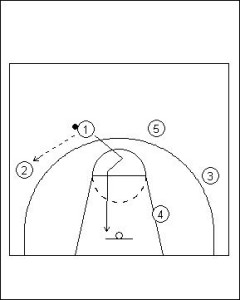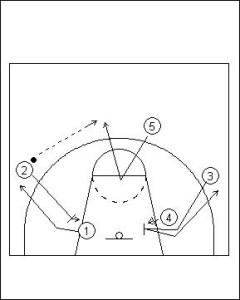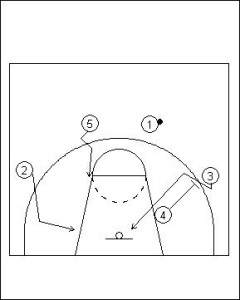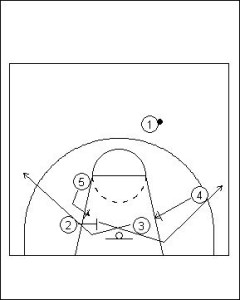Four Out Offense: Triple Screen
The Four Out Offense is a very popular formation in basketball. The Four Out Offense, sometimes called the Single Post offense is used by teams with either a very effective post player or teams that struggle to generate post offense. Either way the offense provides a single post target within the many scoring options.
With four players on the perimeter, the Four Out Offense relies heavily on player movement. Once the ball either enters into the post or advances into the keyway the perimeter players must be very active in filling the receiver spots to provide adequate passing options for the player attacking the basket.
The Four Out Offense Triple Screen Play looks to create scoring opportunities through down screens and then the screeners posting up close to the basket.

Strong side Action / No Low Post
One (1) passes to strong side wing, the cuts to the basket.
This initial pass can of course be made during the team’s primary transition or fast break phase of the offense. This allows for the cut to happen very early and at a considerable distance away from the basket. This should give the offensive player (One) a very good opportunity to simply “out run” and “out hustle” their defensive match-up.
Point of Emphasis:
The Cutter is to break split line, and then sprint aggressively to strong side of basket for a possible scoring opportunity.

Five (5) fakes to initiate a backdoor cut, then replaces to the strong side of the split line
Two (2) reverses the ball to Five (5).
Two (2) and Three (3) sprint in to set a down screen for One (1).
One (1) can cut in either direction (left or right), whichever side One (1) cuts out to, three (3) then moves off the screen in the opposite direction.
Screeners Two (2) and Four (4) open up to become targets for a pass from point position. This pass will be especially effective if the defensive players stay on the back of the screeners during the down screening action.
Scoring Options:
- Five (5) off of catch at the three-point line; in this position depending on the players skills set the player can catch and shoot or dribble and pull up for a jump shot.
- One (1) and Three (3) off of turn out to the three-point line or drive and dish
- Four (4) and Two (2) from pass into post

Weak side Action / Low Post
As ball crosses split line Four (4) sets back screen for Three (3). This action as with the vacant post action can occur early in the balls progression up the floor and result in a very early scoring opportunity.
Three (3) fakes one direction and then dives to basket in opposite direction.
Five (5) flash cuts to weak side high post into receiver spot commonly called the Pinch Post.
Two (2) L cuts into weak side short corner receiver spot as Three (3) clears screen set by Four (4).
Both Five (5) and Three (3) are now in excellent receiver spots depending on what happens with Three (3).
Scoring Options:
- Three (3) on cut to basket.
- Five (5) and Two (2) from assist in second phase of play if three receive pass on cut to basket.

If no pass can be made to three (3) then the following movement takes place.
Four (4) and Five (5) sprint in to set a down screen for Three (3).
Three (3) can cut in either direction (left or right), whichever side Three (3) cuts out to, Two (2) then moves off the screen in the opposite direction.
Screeners Four (4) and Five (5) open up to become targets for pass from point position.
The Triple Screen Play now finishes in the same way as the open post side of the offenses variation.








Leave a Reply